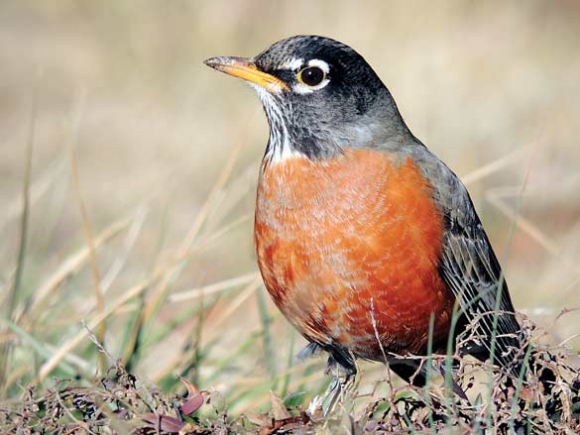Robin redbreasts are a perennial favorite

Our elementary school primers were populated by robins pulling worms out of holes. They appeared on television screens on Saturday mornings, hopping about in Disney cartoons that represented “the idea of a bird.” We know what a robin looks like in outline, but do we know much about the real thing?
The common name is short for “Robin redbreast.” The origin of the second part of the name is obvious, but in reality a mature female’s breast feathers are reddish orange. “Robin” is, of course, the diminutive of Robert. The name was initially applied to the English robin (a warbler with a red breast) and transferred by the early settlers to America’s red-breasted bird.
When I started observing birds, I was surprised to learn that both the robin and the bluebird are members of the thrush family: birds that are large-eyed, slender-billed, strong-legged, and often display spotted breasts. Robins aren’t spot-breasted when mature, but the family characteristic is quite evident when the birds are young. The first time you spot a plump young robin displaying its grayish-black spots, you might have identification problems; that is, until its mother makes an appearance.
Formerly a woodland bird, many robins have now abandoned their forest abodes to nest near human residences where shrubs and scattered trees provide protection and easy access to lawns. In winter, you can easily locate the large nests that the female constructs in the crotch of a small tree or on the horizontal limb of a larger tree. Inside the nest, you will observe a mud cup lined with dry grasses and other vegetation.
Robins feed upon various insects, fruits and berries, but their preferred food — just as the school primers and cartoons indicate — is the lowly but nutritious earthworm. They have been observed using small sticks to rake aside leaves in order to expose worms and insects, an instance of “tool use” not normally associated with birds. They breed throughout North America, from Mexico into northern Canada. According to the Birds of North America web site:
“Massive seasonal migrations occur across large areas of Canada, the U.S. and Mexico as individuals respond to the seasonal availability of soil invertebrates in spring and of fruit in fall. Conspicuous migratory flocks appear in early spring on temperate lawns, the classic harbingers of spring throughout much of the Midwest and eastern U.S. Restless migrant and overwintering flocks are seen in many new areas within the geographic range of the breeding population, where there is either damp soil or fruit resources. Overwintering numbers may vary significantly from year to year in many (especially northern) areas.”
Related Items
A flock that frequented our cove for several winters during the early 1990s may have numbered a thousand birds. They roosted in a stand of large white oaks high on the ridge above our house so as to catch the first warm rays of the morning sun. Then they would gradually work their way down the slopes into the valley as the sun lightened and warmed up the slopes.
In Birds of the South (1933), Charlotte Green noted that, “The greatest migratory flock of robins ever known was seen near New Hope, Gaston County, North Carolina.
Game Warden Ford estimated that there were several millions roosting in the pines. For over a week they wheeled about in the sky, coming to rest in the woods, and in flight they appeared like dark clouds. This great flock was the nearest approach of modern times to the flocks of passenger pigeons which, only a few generations ago, were so numerous that they darkened the earth during their migratory flights … May the day never come when our robin red-breasts will likewise fail to be numbered among the winged travelers of the skies.”
(George Ellison is a naturalist and writer. He can be reached at This email address is being protected from spambots. You need JavaScript enabled to view it..)





